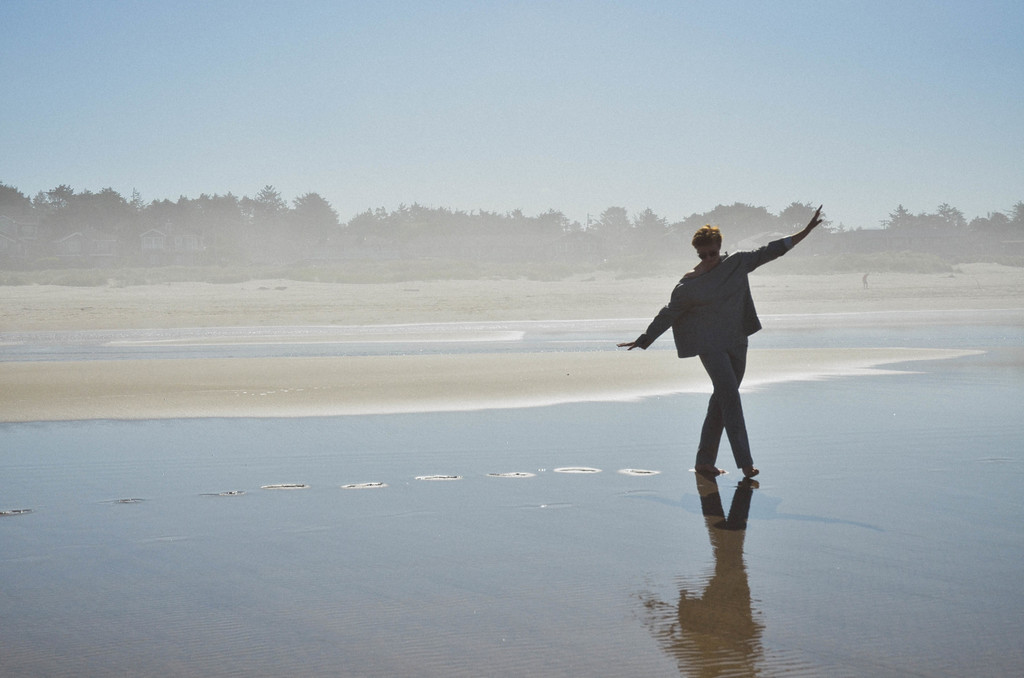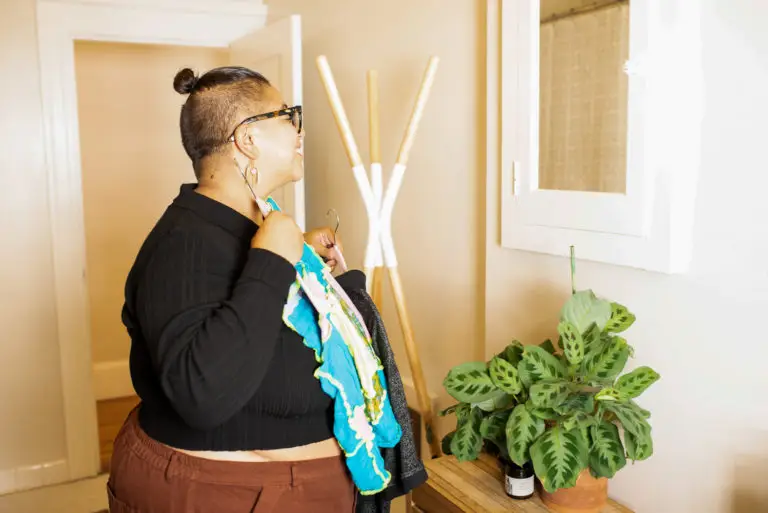By: C.R. Foster (they/he)
The only trans person in the locker room
The public lockers in the gym where I used to lift weights were gummy pink, the color of band-aids or athletic tape. Their surface was dusted with salt, the grit of strangers’ hands, and spots of sweat. I kept my nose close to my locker’s metal door while I blindly twisted the dial on my combination lock. I didn’t need to see the numbers to feel their alignment. In an all-woman space, I was the only trans person, and I kept my body and my eyes to myself as I struggled out of my sweaty exercise clothes, hoping that nobody would see the small markers that identified me as not-female.
Around me, women stroked each others’ freshly shaved legs, compared muscles, and gossiped about their boyfriends’ failings. They draped themselves in towels or walked around nude, grateful for a reprieve from the male gaze. I wriggled out of my sports bra, its sticky Lycra clinging to me like a suit of leeches. As soon as my breasts were gone, I knew I wouldn’t belong in the locker room anymore. Already, my body was skewing male, and as its physically masculine traits became more obvious, I knew my time was running out in the private land of women.
In 2018, I started gender-affirming hormones as part of my long-delayed physical transition and to prepare for top surgery, a double incision mastectomy with nipple grafts. My surgeon told me exercise would reduce my recovery time, but emphasized that my physical condition before surgery was even more important. To help make my body match the way I perceived myself, I needed to change more than my hormones. I needed to pump some iron, too.
In the year I spent building my chest, shoulders, arms, and back, I learned that gyms—and fitness-oriented spaces in general—are rarely inclusive of trans people or those who are non gender conforming. Even in Portland, where I see other trans people on every block, where half the cars have those stupid Love Wins bumper stickers, I am the only visibly trans person in the place where I work out.
Prior to my transition, it never occurred to me that my sense of comfort and belonging in the gym was linked to the way my body looked without interventions. As long as I fit neatly into a pink or blue box, I was welcome. When my gender was less clearly defined, I struggled to feel like I had access to a vital coping mechanism.
My trans friends talk about exercise wistfully, something they miss. As a trans person, any action is politicized. Using a bathroom, buying shoes, running in public: the everyday activities that non-transgender people do without thinking are loaded with potential stress and conflict for the rest of us. We all worried about locker rooms, where to change. None of us swim. There is an economic factor, too: transgender people are more likely to be unemployed and living below the poverty line, prohibiting access to gyms or paid spaces.
I have never seen another visibly trans person in the gym. “Free” exercise, which implies access to safe, public spaces and leisure time, is not an option for many of us, either. For example, I have never seen one of us running laps at the school field. My friends say the risk isn’t worth the benefits. One friend told me about the truck that followed them on a leisurely jog; another, who joined a big box gym, shared stories about being aggressively hit on and insulted by other gym members.
When I looked like a woman, my desire for strength was seen as transgressive. Women, especially competitive athletes, have struggled for more than a century to be seen as equals on the playing field. Muscular women toured as circus freaks; strength was an “unfeminine” quality that made powerful women into monsters. Women are also conditioned from childhood to see their bodies as adversaries, to be punished in the gym. Diet and exercise often go hand-in-hand for women, while men are encouraged to lift heavy and eat what they want. Women do aerobics. Men lift. Those gender lines are arbitrary but deeply enforced. Those of us who fall between the genders or outside gender norms are the ones on the wrong side of the gym: the only man in Zumba class, the only woman in the squat rack, or me, the only trans person in the locker room. I wasn’t comfortable in woman-only spaces not only because I didn’t identify as female, but also because my trans body eventually drew uncomfortable glances and comments from the women who changed near me.
I always stayed close to the lockers and hid the front of my body, my head practically inside the dark cabinet where I’d piled my clothes and shoes. I didn’t want to be accused of peeking. However, I also knew that as my shoulders and back broadened and my body fat relocated to my middle from my hips and thighs, that my silhouette was undeniably masculine. I wore boy-style briefs, not feminine underwear; my clothes were men’s clothes. Once, changing at a bench near the door, I startled a woman.
“Am I in the wrong place?” she chirped. She looked me up and down, checked the “women” sign on the door, and frowned.
“No,” I said. “I’ll be out in a minute.”
Her eyes flicked to the sign, back to me. I wasn’t passing anymore. I had become something not-female, a threat. Her smile was sharp and brilliant but her eyes were flat. She sidled around me and vanished behind a bank of lockers. All she had to say was there’s a man in here and I’d be in trouble—though I wasn’t a man, didn’t ever want to be one. I tied my shoes with shaking hands and grabbed my coat. My body was finally aligning with my gender presentation, but at the cost of security.
To reform and train my body to a masculine aesthetic, I enlisted help. A gym membership gave me access to trainers who charged an hourly rate to put me through a specially designed program to beef up my arms and chest and get me ready for top surgery. The price, which ran anywhere from $30 to $65 per hour, was prohibitive, but I paid it. I didn’t want to risk a negative outcome from my procedure. Yet, beyond the cost, there were other pitfalls. Trainers are highly attuned to cultural beauty standards and as long as I looked like a woman, I was treated like one. Without fail, every trainer offered me advice to “tone” my body. They assumed I wanted to lose weight and was afraid to pick up anything heavier than 15 lbs. The last trainer I worked with before I started testosterone was shocked when I told him I wanted to gain weight and that my only fitness goal was to be able to lift the front end of a Fiat, like Franco Columbu in Pumping Iron.
“Aren’t you worried about looking too muscular?” he stuttered.
“Train me like you train yourself,” I said. “I’m not worried about getting big.”
One day, after putting on my workout clothes in a bathroom stall, I walked across the open changing area. The women’s voices fell silent. One woman, who was sitting nude on a bench, grabbed a towel and covered herself, scowling at me. As I slipped out the door to the weight room, I heard the whispering start behind me. My face was on fire and I struggled to keep a lid on my tears. I’m not a man, I wanted to say. But it didn’t matter. I was done. I did a few half-hearted sets of deadlifts and then grabbed my clothes without bothering to shower or change. I knew better than to insist on taking up “women’s space,” so fiercely guarded. I didn’t want to justify my right to go where I felt comfortable, not where others decided I fit in. I didn’t want to have to explain the complexities of gender theory to the gym’s employees or members, convincing them that as an AFAB nonbinary trans person I was not a threat, just an outlier. It was not a battle worth having, for $45 a month. I canceled my membership.
Instead, I found a crossfit gym near my house—no locker rooms—and a trainer who was more focused on my goals than my gender identity.
My new trainer shrugged when I said I was transitioning, assessed my squat form, and gave me an honest appraisal of how long it would take me to build the kind of chest my surgeon wanted. He was a competitive Crossfitter, with a background in bodybuilding and decades of experience coaching. He looked like Daniel Craig’s body double; you could shred cheese on his abs. He gave me his program without arguing or trying to talk me into a more “feminine” aesthetic. Within a couple months, I was sprinting around the block effortlessly, deadlifting well over 200 pounds, and bench pressing my weight. After each session, I went home drenched, pecs throbbing.
My surgeon was the last person who saw my old chest. Two days before top surgery, I sat shirtless on her exam table, hoping that my body was ready for the three-hour operation. She palpated the upper half of my left pec. My chest had transformed from a feminine pair of breasts to muscle as my breasts lost their fat and the texture of their tissue changed from rubber to paper.
“You’re solid,” she said.
“I’ve been working out.”
“This makes my job much easier,” she said, eyeing my nipple alignment. “We’re not going to have any problems.”
When the bandages came off a few weeks after surgery, I saw that she was right. Every pull-up was there, right under my skin. I felt whole and strong. I’d spent a year building this, and I had the rest of my life to enjoy it.
C.R. Foster (they/he) is a queer, nonbinary trans writer who lives in Portland, Oregon. Foster is the co-writer of the bestselling nonfiction book Unsettled (St. Martin’s Press, 2021) with recovery advocate Ryan Hampton. Foster also wrote short story collection Shine of the Ever (Interlude Press, 2019), which O: The Oprah Magazine named as one of the best LGBTQ books of the year. Their writing has gone viral and appears on NPR, in The New York Times, Bright Wall/Dark Room, McSweeney’s Internet Tendency, and many other journals.
As the largest provider of gender-affirming care for the trans and nonbinary community, Plume is committed to providing information about many types of information, including questions about hormones like estrogen and testosterone, gender transitioning tips and experiences, and guidance on social transition and self care.
While we strive to include a diverse range of voices and expertise, not everything will be for every person. Each individual’s experience is unique, and the information Plume provides is not intended to be a substitute for professional medical advice, diagnosis, or treatment.
Always first seek the advice of your primary and/or specialist physician, the Plume Care Team, or other qualified health provider with any questions you may have regarding a medical condition, your mental health and emotional needs, or your health care needs regarding gender-affirming hormone therapy. If you are experiencing an emergency, including a mental health crisis, call 911 or reach out to Trans LifeLine.




